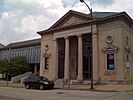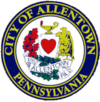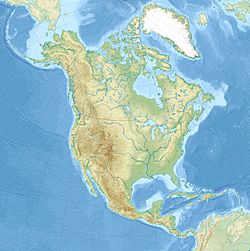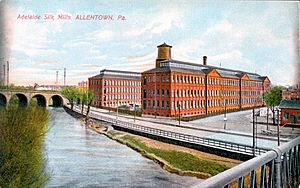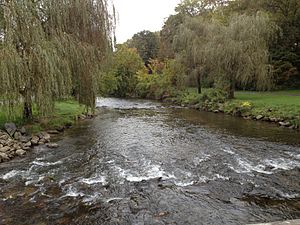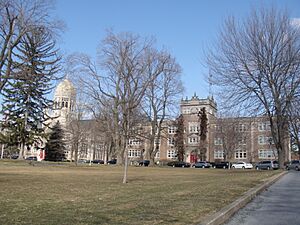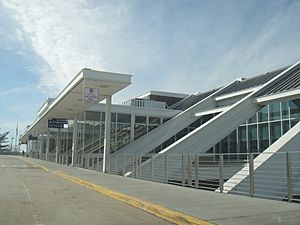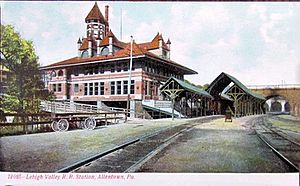Allentown, Pennsylvania facts for kids
Quick facts for kids
Allentown, Pennsylvania
|
|||||
|---|---|---|---|---|---|
|
Home rule municipality
|
|||||
|
Americus Hotel on Hamilton Street
Muhlenberg College
|
|||||
|
|||||
| Nicknames:
"The A" "The Queen City", "A-Town", "Band City USA", "Peanut City", "Silk City".
|
|||||
| Motto(s): | |||||
| Country | United States | ||||
| State | Pennsylvania | ||||
| County | Lehigh | ||||
| Settled | 1751 | ||||
| Founded | 1762 | ||||
| Incorporated | March 12, 1867 | ||||
| Founded by | William Allen | ||||
| Named for | William Allen | ||||
| Government | |||||
| • Type | Mayor-council | ||||
| Area | |||||
| • Home rule municipality | 18.01 sq mi (46.64 km2) | ||||
| • Land | 17.56 sq mi (45.49 km2) | ||||
| • Water | 0.44 sq mi (1.15 km2) | ||||
| • Urban | 261.55 sq mi (677.4 km2) | ||||
| • Metro | 730.0 sq mi (1,174.82 km2) | ||||
| Elevation | 338 ft (103 m) | ||||
| Highest elevation | 440 ft (130 m) | ||||
| Lowest elevation | 255 ft (78 m) | ||||
| Population
(2020)
|
|||||
| • Home rule municipality | 125,845 | ||||
| • Rank | 1st in the Lehigh Valley 3rd in Pennsylvania |
||||
| • Density | 7,164.94/sq mi (2,766.35/km2) | ||||
| • Urban | 621,703 (US: 68th) | ||||
| • Urban density | 2,377.0/sq mi (917.8/km2) | ||||
| • Metro | 865,310 (US: 68th) | ||||
| • Metro density | 1,117.8/sq mi (431.6/km2) | ||||
| • Demonym | Allentonian | ||||
| Time zone | UTC−5 (EST) | ||||
| • Summer (DST) | UTC−4 (EDT) | ||||
| ZIP Codes |
18101, 18102, 18103, 18104, 18105, 18106, 18109, 18175, and 18195
|
||||
| Area codes | 610 and 484 | ||||
| FIPS code | 42-02000 | ||||
| GNIS feature ID | 1202899 | ||||
| Primary airport | Lehigh Valley International Airport- ABE (Major/International) | ||||
| Secondary airport | Allentown Queen City Municipal Airport- XLL (Minor) | ||||
| School district | Allentown | ||||
| Major hospital | Lehigh Valley–Cedar Crest | ||||
Allentown (Pennsylvania Dutch: Allenschteddel, Allenschtadt, or Ellsdaun) is the county seat of Lehigh County, Pennsylvania, United States. It is the third-most populous city in Pennsylvania with a population of 125,845 as of the 2020 census and the most populous city in the Lehigh Valley metropolitan area, which had a population of 861,899 and was the 68th-most populous metropolitan area in the nation as of 2020.
Founded in 1762, Allentown is located on the Lehigh River, a 109-mile-long (175 km) tributary of the Delaware River. It is the largest of three adjacent cities, including Bethlehem and Easton in Lehigh and Northampton counties, in the Lehigh Valley region of eastern Pennsylvania. Allentown is located 48 miles (77 km) north of Philadelphia and 78 miles (126 km) west of New York City.
Contents
History
18th century
In the early 1700s, the area that is present-day Allentown was a wilderness of scrub oak, where the Lenape, a Native American tribe, fished for trout and hunted for deer, grouse, and other game. In 1736, this large area north of Philadelphia was deeded by 23 chiefs of the Five Civilized Tribes to three sons of William Penn, founder of the colonial-era Province of Pennsylvania: John Penn, Thomas Penn, and Richard Penn. The price for the land included shoes, buckles, hats, shirts, knives, scissors, combs, needles, looking glasses, rum, and pipes.
On May 18, 1732, the land was deeded by Thomas Penn to Joseph Turner, an iron manufacturer and politician from Philadelphia. Two years later, on September 10, 1735, a 5,000-acre (20 km2) part of the land was purchased from Turner's business partner by William Allen, a wealthy shipping merchant and former mayor of Philadelphia.
The land was surveyed in 1736 and again in 1753 as part of an effort to construct a road from Easton in the east to Reading in the west. The 1753 survey reported that a log house, owned by Allen and built around 1740, existed near the western banks of Jordan Creek. The house was used primarily as a hunting and fishing lodge by Allen, but he also used it to entertain prominent guests, including James Hamilton, his brother-in-law, and John Penn, then governor of the Province of Pennsylvania. In 1752, Northampton and Berks counties were formed; Easton was named the county seat of Northampton County, and Reading the county seat of Berks County.
In 1762, the land, including present-day Allentown, was named and laid out by Allen. A rivalry between the Penns and Allen may have inspired Allen to acquire the land and found the city. In 1763, a year after Allentown's founding, an effort was made by Allen and others to move the county seat from Easton to Allentown, but the Penns' influence prevailed and the county seat remained in Easton.
The city's original organization, whose archives are now housed at the Historical Society of Pennsylvania in Philadelphia, included 42 city blocks and 756 lots, most of which were 60 feet (18 m) in width and 230 feet (70 m) in depth. The city was initially located between present-day 4th and 10th streets and Union and Liberty streets and was initially named Northampton Towne.
Many streets on the original plan were named for Allen's children, including Margaret (present-day 5th Street), William (now 6th Street), James (now 8th Street), Ann (now 9th Street), and John (now Walnut Street). Allen Street (now 7th Street), the city's main street, was named for Allen himself. Hamilton Street was named for James Hamilton, deputy governor of colonial-era Pennsylvania from 1748 to 1754. Gordon Street was named for Patrick Gordon, an earlier deputy governor of colonial Pennsylvania. Chew Street was named for Benjamin Chew, and Turner Street was named for Allen's business partner Joseph Turner.
Allen hoped that the city would displace Easton as the seat of Northampton County and become a major national center for commerce due to its location along the Lehigh River and its proximity to Philadelphia, which was then the nation's largest and most influential city. In 1767, Allen granted the land to his son James.
American Revolutionary War

Allentown played a central role in both inspiring the American Revolution and supporting the subsequent Revolutionary War. Some of the first Patriot resistance to British colonialism in the Thirteen Colonies began in and around present-day Allentown. On December 21, 1774, a Committee of Observation was formed by Allentown-area patriots. Following the Declaration of Independence's unanimous signing by the Second Continental Congress, British governing control in Allentown began to break down as patriot militias expanded their resistance. The patriot militias also pressured Tories out of the city, and expanded their ranks, which were ultimately incorporated into the Continental Army. The burden of supplying the local militias fell on the people, and requisitions for food, grain, cattle, horses, and cloth were common.
During the Revolutionary War, Hessian prisoners of war were kept in Allentown in the vicinity of present-day Seventh and Gordon streets. Allentown also housed four hospital structures, including one at Zion Reformed Church and one on the grounds of the present-day Farr Building, that were used in treating wounded Continental Army troops.
After crossing the Delaware and prevailing in the Battle of Trenton on December 26, 1776, Continental Army commander George Washington and his staff traveled through Allentown, where they proceeded up present-day Lehigh Street, then called Water Street. They stopped at the foot of the street at a large spring at the present-day Wire Mill. There, Washington and his troops rested and watered their horses, and then proceeded to their post of duty.
In 1777, a manufacturer of paper cartridges and muskets for the Continental Army relocated to Allentown from neighboring Bethlehem, and a shop of 16 armourers was established on Little Lehigh Creek, which was used to repair Continental Army weapons and manufacture saddles and scabbards for their use.
Liberty Bell's hiding
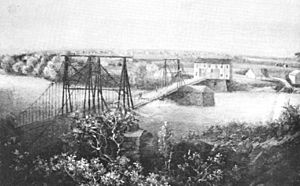

Allentown holds historical significance as the location where the Liberty Bell, then known as the State House Bell, was successfully hidden for nine months by American patriots to avoid its capture by the British Army after the fall of Philadelphia during the Revolutionary War.
After George Washington's defeat at the Battle of Brandywine in Chadds Ford Township, Pennsylvania on September 11, 1777, the revolutionary capital of Philadelphia was left defenseless and American patriots began preparing for what they saw as an imminent British attack on the city. Pennsylvania's Supreme Executive Council ordered that 11 bells, including the State House Bell, now known as the Liberty Bell, and ten other bells from Philadelphia's Christ Church and St. Peter's Church, be taken down and moved out of Philadelphia to protect them from the British Army, which would melt the bells down to cast into munitions. The bells were transported north to present-day Allentown by two farmers and wagon masters, John Snyder and Henry Bartholomew, and then hidden under floorboards in the basement of Zion Reformed Church at present-day 622 Hamilton Street in Center City Allentown, just prior to Philadelphia's September 1777 fall to the British.
19th century
In 1803, the city, whose mail had been previously been received in neighboring Bethlehem, had a post office established inside Compass and Square Hotel in the present-day Penn National Bank building at 645 Hamilton Street in Allentown. In the 1810 U.S. census, the city's population exceeded 700 residents, and the Commonwealth of Pennsylvania granted Northampton Towne legal standing on March 18, 1811, incorporating it initially as the Borough of Northampton in what was then Northampton County. The new borough's government first undertaking was ordering that cows in the city be moved from public streets to pastures, which proved unpopular with city residents. The following year, the city became part of Lehigh County, which was partitioned from a western section of Northampton County.
Throughout the early 1800s, the city grew primarily as a court and market town. Northampton Bank, the city's first bank located at the northeast corner of Center Square, was chartered in July 1814, and the first Hamilton Street Bridge, a 530 feet (160 m)-long chain structure, was constructed over the Lehigh River. The bridge featured two suspended lanes, one for east and one for westbound traffic, and a toll house at the bridge's western end. In 1829, Lehigh Canal, a 46.6 miles (75.0 km)-long canal on the Lehigh River's east side, was completed for both ascending and descending navigation. Its construction was the most important factor in making anthracite coal, one of the nation's most important domestic and industrial fuels, available to the nation's largest industrial markets in New York City, Philadelphia, and elsewhere. In 1855, the first railroad was built on the Lehigh River's west side, and rail soon began to surpass river transport as the means for transporting anthracite through the city.
In 1838, the city's name was officially changed to Allentown. But it soon faced major challenges. In 1841, a flood swept away Hamilton Street Bridge and inflicted substantial damage on areas of the city near the Lehigh River. Two years later, in 1843, Northampton Bank failed following excessive speculation by the bank, resulting in financial ruin for many bank customers. Five years later, on June 1, 1848, a large fire burned down most of Allentown's central business district between 7th and 8th streets on Hamilton Street.
During the 1850s, however, the city began recovering. A new bridge was built across the Lehigh River, and brick buildings were constructed to replace wooden ones that were burned in the 1848 fire. In 1852, the first Allentown Fair, now one of the nation's longest continual annual fairs, was held.
American Civil War


On April 13, 1861, with tensions between the nation's North and South intensifying following the South's secession and the Confederate attack on Fort Sumter, residents of Lehigh and Northampton counties called a public meeting in Easton to take steps to support the federal government. At the meeting, citizens voted to establish and equip the 1st Pennsylvania Volunteer Infantry, a new military unit, placing Captain Samuel Yohe of Easton and Thomas W. Lynn in charge and awarding them the respective ranks of colonel and major. Tilghman H. Good of South Whitehall Township, previously captain of the Allentown militia known as the Allen Rifles and commander of the 4th Pennsylvania Infantry Regiment, was placed in charge of the 1st Pennsylvania's Company I, which included his former Allen Rifles subordinates and members of the Jordan Artillerist, another Allentown-based militia.
In April 1861, these Allentown units were deployed in response to President Lincoln's call for 75,000 volunteers to defend the national capital in Washington, D.C., following the Confederate bombardment of Fort Sumter.
After the Civil War's end, many of these soldiers were named Pennsylvania First Defenders in recognition of their role as one the first five units to answer Lincoln's call for volunteers to defend the national capital. After protecting Washington, D.C., from April to July 1861, they were honorably discharged and returned home. However, a significant number of them reenlisted with the Union Army to defend the nation amidst the Civil War's escalation.
47th Regiment, Pennsylvania Volunteer Infantry
On August 5, 1861, Andrew Gregg Curtin, Pennsylvania's Civil War-era governor, granted Tilghman H. Good authority to create the 47th Pennsylvania Infantry Regiment, a new unit commonly known as the 47th Pennsylvania Volunteers. Good secured help from William H. Gausler of Allentown, who was commissioned as a major with the regiment's central command staff, and John Peter Shindel Gobin, a senior officer with the Sunbury Guards in Northumberland County, who was repeatedly cited for valor and was promoted to colonel and ultimately commanding officer of the regiment. Companies A and E of the regiment were recruited primarily from Easton and Northampton County; Companies B, G, I, and K were largely recruited from Allentown; Company C was recruited from Northumberland and Juniata counties; Company F was primarily composed of men from Catasaqua; and Companies D and H were recruited from Perry County. The 47th Pennsylvania Volunteers achieved Union victories at the Battle of St. Johns Bluff in Florida (October 1–3, 1862) before suffering a costly defeat in the Second Battle of Pocotaligo in South Carolina (October 21–23, 1862). They were the only Pennsylvania regiment to fight in the Union Army's 1864 Red River campaign across Louisiana.
While sustaining numerous casualties during the Red River campaign in the spring of 1864, the 47th Pennsylvania helped turn the Civil War in the Union's favor with victories in General Sheridan's 1864 Shenandoah Valley campaign across Virginia, including in the Battles of Berryville, Opequan, Fisher's Hill, and Cedar Creek and then again contributing to the defense of the nation's capital following Lincoln's assassination on April 15, 1865. Other known Union Army units from Allentown included the 5th, 41st, 128th, and 176th Pennsylvania Infantries.
On October 19, 1899, Allentown erected and dedicated the Soldiers and Sailors Monument at Hamilton and S. 7th streets in the Center City, where it still stands, in honor of these Union soldiers from Allentown and local Lehigh Valley towns and boroughs who were killed in defense of the Union's preservation during the Civil War.
Industrialization

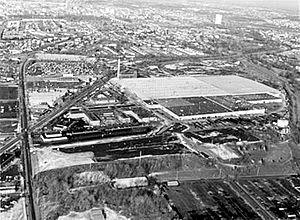
Beginning in the late 18th century, the city began to slowly grow as a hub for commerce and industrialization and as a colonial-era population center. Prior to the American Revolution, there were 54 homes in Northampton Towne and approximately 330 residents. In 1782, there were 59 houses and over 100 cows were stabled in the town. The town was described by a visitor in 1783, "One gets a glimpse of many good stone houses, many of them very neat, and everything about the premises shows good order and attention. The people are mainly German who speak bad English and distressing German." In 1795, the U.S. Gazetteer described Allentown as:
A handsome and flourishing town of Northampton County, pleasantly situated on the point of land formed by the junction of the Jordan Creek and Little Lehigh. It is regularly laid out and contains about ninety dwellings, a German Lutheran and a Calvinist (Zion) Church, an Academy and three merchant mills.
In 1792, land north of Allentown was purchased by Lehigh Coal & Navigation Company for coal mining, but it initially proved difficult to transport the region's high quality anthracite coal over the primitive trail system that then existed, resulting in only a limited amount of anthracite being mined until 1818, when the company began constructing the Lehigh Canal to transport coal from Mauch Chunk, later renamed Jim Thorpe, down the Lehigh River to the river's confluence with the Delaware River in Easton.
The opening of Lehigh Canal in 1818 quickly transformed Allentown and the surrounding Lehigh Valley from a rural agricultural area dominated by German-speaking people into one of America's first urbanized industrialized areas and expanded the city's commercial and industrial capacity. With this, Allentown underwent significant industrialization, ultimately becoming a major center for heavy industry and manufacturing.
Allentown's industrial development accelerated in the late 18th century. David Deshler, Allentown's first shopkeeper, opened a sawmill in the city in 1782. By 1814, industrial plants in Allentown included flour mills, sawmills, two saddle makers, a tannery and tan yard, a woolen mill, a card weaving plant, two gunsmiths, two tobacconists, two clockmakers, and two printers. In 1855, the first railroads to reach Allentown were opened, presenting the Lehigh Canal with direct competition for coal transport. Lehigh and Susquehanna Railroad ordered four locomotives, and train stations were built in Allentown, Easton, and Mauch Chunk. In September 1855, the railroad became operational with the Central Railroad of New Jersey providing transport between Allentown and New York City. Transport between Allentown and Philadelphia was made available through Perkiomen Railroad, which operated between Norristown and Freemansburg.
In the 1840s, iron ore beds were discovered in hills around Allentown, and a furnace was constructed in 1846 by Allentown Iron Core Company for production of pig iron, a vital component used in the manufacturing of steel. The furnace opened in 1847 under supervision of Samuel Lewis, an expert in iron production, and was followed by the opening of other Allentown plants for production of a wide variety of metal products. In 1860, several smaller iron companies merged to create the Allentown Rolling Mill Company, which became Allentown's largest iron company and contributed to the city and the greater Lehigh Valley region's emergence as a major source for iron ore.
In 1850, Leh's, a shoe and ready-to-wear clothing store, was opened in the city by Henry Leh. By 1861, with the Civil War commencing, Leh's emerged as a major source of military boots for the Union Army. In addition to Leh's, eight brick yards, a saw mill, a paint factory, two additional shoe factories, a piano factory, flour mills, breweries, and distilleries all opened in Allentown during the Civil War era.
In 1883, Allentown Boiler Works was founded in Allentown by Charles Collum. Collum and his partner John D. Knouse built a large facility at 3rd and Gordon streets in Allentown's First Ward near the Lehigh Valley Railroad yard near what later became Kline's Island. The company manufactured iron products, some of which were used in the construction of high-profile construction projects, including the building of the White House in Washington, D.C., and the U.S. Military Academy at West Point. The company's boilers and kilns were used for the production of iron products sold nationally and internationally, including to customers in Canada, Cuba, and the Philippines.
Brickworks flourished in Allentown through the end of World War I. The clay unearthed in various sections of Allentown and the city's suburbs proved suitable in manufacturing building brick and fire brick. Bricks were the first Allentown products shipped by rail and sold nationally. A vibrant food processing industry began emerging in Allentown following the arrival of predominantly German immigrant bakers, who were among Allentown's first settlers. In 1887, Wilson Arbogast and Morris C. Bastian formed Arbogast and Bastian, which provided large scale commercial slaughtering.
With industrialization, Allentown emerged as a major regional and national center for banking and finance. In 1860, William H. Ainey founded Allentown Savings and served as its first president. In 1864, Second National Bank of Allentown was formed, and Ainey was elected its first president, a position he held until his death. Ainey contributed to Allentown's industrial and retail growth, helping finance Iowa Barb Wire Company, which was later absorbed by American Steel & Wire, Pioneer Silk Factory, Palace Silk Mill, and Allentown Spinning Company.
In the late 1870s, Allentown's iron industry collapsed, leaving the city economically depressed. Efforts were made to diversify the city's industrial base, including convincing Phoenix Manufacturing Company to open a silk mill in Allentown. Adelaide Mill at Race and Court streets prompted the opening of Pioneer Silk Mill in 1886, and the city quickly emerged as a national leader in silk manufacturing. The silk industry grew to ultimately become Allentown's largest industry in the late 19th century and remained the city's largest industry through the end of the 20th century. In 1914, there were 26 silk mills in the city. By 1928, after the introduction of rayon, the number of Allentown silk mills grew to 85, and over 10,000 people were employed in the Allentown silk industry at the industry's height in the 1940s.
In 1896, Max Hess, a retailer from Perth Amboy, New Jersey, visited Allentown and set about developing Allentown's first department store. He his brother Charles opened Hess Brothers at 9th and Hamilton streets. Hess's developed a reputation for flamboyance, offering the latest European fashion apparel. The opening of Hess's was following by the opening of a second major department store in the city, the Zollinger-Harned Company, located in the Zollinger-Harned Company Building on Hamilton Street.
In the late 19th century, Allentown also emerged as a major center for the beer brewing industry. Notable Allentown breweries included Horlacher Brewery (founded 1897, closed 1978), Neuweiler Brewery (founded 1875, closed 1968), and Schaefer Beer, whose brewery was later acquired by Pabst and Guinness and is now owned by Boston Beer Company, brewer of Samuel Adams beer.
20th century
In 1905, Jack and Gus Mack moved Mack Trucks, their motor company, from Brooklyn to Allentown, taking over the foundries of Weaver-Hirsh on South 10th Street. By 1914, Mack Trucks developed a global reputation for manufacturing sturdy and reliable trucks and vehicles. Many were sent to Western Front battlefields in France prior to the U.S. formally entering World War I in 1917. The British nicknamed Mack AC's five and seven-ton trucks the "Bulldog". Mack eventually grew to have eight manufacturing plants in Allentown and adopted the bulldog as it corporate brand.
Like several other regions in Pennsylvania, Allentown residents continued speaking Pennsylvania German well into the early 20th century. Pennsylvania Guide, compiled by the Writers' Project of the Works Progress Administration, described the Pennsylvania Dutch community's impact on Allentown's linguistic landscape, reporting in 1940 that:
Allentown is among the few large Pennsylvania cities where newspapers still carry columns written in the dialect. Although English predominates on the streets, there is a tendency to enunciate the 'v' with open lips, to soften the hard 'g' into 'ch,' and to use too frequently such words as 'already,' 'yet,' and 'once.' Here also are heard such colloquialisms as 'the pie is all,' (all gone) and 'it wonders (mystifies) me.'
In October 1945, following the end of World War II, Western Electric opened a plant on Union Boulevard in Allentown. Six years later, on October 1, 1951, the company manufactured and released the world's first transistor, which was produced at the Allentown-based plant, and the Allentown-based company emerged as a leader in the nation's post-war electronics revolution.
By the mid-20th century, Allentown was a major retailing and entertainment center distinct and separate from Philadelphia and New York City. Hess's, Leh's, and Zollinger department stores led to retail sector growth in Allentown, and dozens of smaller retail stores, restaurants, hotels, banks, and professional offices in the city emerged in present-day Center City, which was then referred to as downtown Allentown. At least seven cinemas and stage theaters were developed on Hamilton Street between 5th and 10th streets.
Deindustrialization and Rust Belt

By the mid-1960s, Allentown's economy had been booming for decades but the city's rising taxes and regulations prohibiting expansion of the city's geographic limits began leading many of the city's residents, especially those in the post-World War II baby boom generation, to flee Allentown for its suburbs. Salisbury, South Whitehall, and Whitehall townships each had large areas of farmland that were prime locations for residential real estate development. Much of Allentown's working class began migrating to these newer, less-expensive housing developments in Allentown's suburbs, which offered lower taxes, more green space, less crime, and newer schools.
This demographic trend continued throughout the latter part of the 20th century, presenting a major challenge to Allentown's city government and the Allentown School District as it confronted greatly diminished resources. Allentown School District's financial challenges, in turn, further increased the working class flight to Allentown's suburbs, creating a sea change in the city's demographics. With the departure of many working-class families from older Center City neighborhoods, many homes were sold to landlords who converted them into inexpensive multifamily apartments, many of which became government-subsidized housing projects that were permitted under the city's lax zoning and city codes.
With Allentown's neighborhoods and school system declining, the city focused on attempting to develop its Hamilton Street retail district, largely ignoring Allentown neighborhoods not located in Center City. This also exacerbated the flight of Allentown families to the city's suburbs, leading to the development of shopping centers and services to accommodate the demand in these expanding suburban communities. In 1966, Whitehall Mall, the first closed shopping mall north of Philadelphia, opened in Whitehall Township.
Ten years later, in 1976, the even larger Lehigh Valley Mall opened north of U.S. Route 22 in Fullerton. Stores in Allentown's downtown shopping district began closing, replaced with stores whose customers were less affluent. Large areas of Allentown's downtown were subsequently razed and replaced with parking lots. The downtown business district was rebuilt in an attempt to compete with the newer suburban shopping locations. A multiblock row of stores known as Hamilton Mall was developed, featuring newly covered sidewalks and managed traffic patterns. But the effort was unsuccessful, and two of the city's major department stores, Leh's and Zollingers, were forced to close by 1990. The third, Hess's, was sold to The Bon-Ton in 1994, which closed its Hamilton Mall location two years later in 1996. In 1993, the Corporate Center, the city's new flagship business center on North 7th Street, fell victim to a large sinkhole, which led to its condemnation and ultimate demolition.
21st century
Combined with challenges confronting Center City, the manufacturing economy of the Northeastern United States began suffering from deindustrialization associated with foreign competition, trade policies, and manufacturing costs. Many Allentown factories and corporations began closing or relocating.
Responding to the late 20th century economic downturn, Allentown consciously sought to begin diversifying its economy in the early 21st century. In the 2000s and 2010s, Allentown's economy saw growth in its service, health care, transportation, warehousing, and some manufacturing industries. In 2009, the Neighborhood Improvement Zone (NIZ), created by the Pennsylvania State Legislature, sought to address Allentown's economic challenges and encourage its development and revitalization. The NIZ includes approximately 128 acres (52 hectares) in Center City and the city's riverfront district on the Lehigh River's western side.
In 2006, Agere Systems, formerly Western Electric, was acquired by LSI Corporation and relocated to San Jose, California. Mack Trucks relocated to Greensboro, North Carolina, in 2009, and other Allentown-based factories downsized considerably or ceased operations entirely. With the city's manufacturing base eroded, once high-paying industrial jobs were replaced with lower-paying service sector jobs, and Allentown began being cited widely as one of the most prominent examples of a late 20th century Rust Belt city.
In 2014, Center City underwent major restructuring, including constructing and opening PPL Center, a 10,500-capacity indoor arena that now hosts the Lehigh Valley Phantoms, a professional American Hockey League ice hockey team, and other sports, entertainment, and concert events. A full-service Renaissance Hotel also opened, and older office buildings were redeveloped.
In its 2024 edition of "Best Places to Live", U.S. News & World Report ranked Allentown the fifth-best location in the nation to retire.
Geography
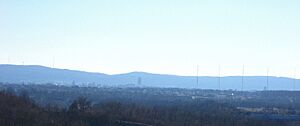

Topography
Allentown's geographic boundaries include a total area of 18.0 square miles (46.6 km2). Of this, 17.8 square miles (46.1 km2) is land and 0.2 square miles (0.5 km2) is water, according to the U.S. Census Bureau. Bodies of water include Jordan Creek and its tributary, Little Lehigh Creek, which join within the city limits and empty into the Lehigh River. Other bodies of water in Allentown include Lake Muhlenberg in Cedar Creek Parkway and a pond in Trexler Park.
Adjacent counties
Allentown is located in the Lehigh Valley, an eastern Pennsylvania geographic valley located between two Appalachian mountain ridges, Blue Mountain, which varies from 1,000 feet (300 m) to 1,600 feet (490 m) in height about 17 miles (27 km) north of the city, and South Mountain, a ridge of 500 feet (150 m) to 1,000 feet (300 m) in height that borders Allentown's southern edge. It includes both Lehigh and Northampton counties.
The Lehigh Valley's adjacent counties include Carbon and Monroe counties to its north, Bucks County to its southeast, Montgomery County to its south, Berks and Schuylkill counties to its west, and Warren County, New Jersey to its east.
Cityscape and neighborhoods
Center City, which includes the downtown area and its 7th Street retail and residential corridor, is the city's central business district and the location of most of its city, county, and federal government buildings. To the east of Center City are The Wards, residential areas developed during Allentown's late 19th century and early 20th century industrial boom. Just east of the Lehigh River are the city's East Side residential neighborhoods, most of which border various routes to neighboring Bethlehem. South of Center City and across Little Lehigh Creek are the city's South Side neighborhoods, which border Emmaus. Allentown's West End, with a mix of commercial corridors, cultural centers, and larger single-family residences, begins approximately west of 15th Street.
Center City's tallest building is the PPL Building at 322 feet (98 m). In addition to the PPL Building, Center City commercial office buildings include the Dime Savings and Trust Company building, which features the Art Deco architecture of the region during the 1920s and 1930s. One City Center, Two City Center, and other commercial buildings are located in Center City.
An 8,500-seat indoor arena, PPL Center, which hosts the Lehigh Valley Phantoms of the American Hockey League, opened in August 2014 at 701 Hamilton Street in Center City. Other Center City historic and recreational landmarks include Allentown Art Museum, Baum School of Art, Lehigh County Historical Society, and Miller Symphony Hall.
In January 2015, two major hotels, Americus Hotel and a Marriott, opened in Center City.
Architecture
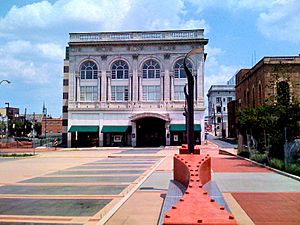
Allentown is characterized by a large stock of historic homes, commercial structures, and century-old industrial buildings reflecting its standing as one of the nation's earliest urban centers. Center City's neighborhoods include Victorian and terraced rowhouses. West Park includes mostly Victorian and American Craftsman-style architecture. Houses on Allentown's tree-lined streets in the West End were built mostly between the 1920s and 1940s. Houses in Allentown's East and South Sides are a mixture of architectural styles and are generally single and twin family homes built between the 1940s and 1960s; both areas include some older Victorian homes. Allentown has many loft apartments in converted mills and historic brick manufacturing buildings and modern and historic high-rise apartment buildings in Center City.
Allentown has three primary historic districts: Old Allentown, the Old Fairgrounds, and West Park. Old Allentown and Old Fairgrounds are Center City neighborhoods that hold a joint house tour organized by the Old Allentown Preservation Association (OAPA) annually in September. West Park also offers a tour of its Victorian and Craftsman-style homes.
The PPL Building, at 2 North 9th Street, is Allentown's tallest building at 322 feet (98 m). The building was designed by New York City architectural firm Helme, Corbett, and Harrison. Wallace Harrison was the primary designer of the building, which later served as a prototype for the Art Deco architecture of Rockefeller Center and other New York City building structures. Built between 1926 and 1928, the PPL Building's exterior decorative friezes were designed by Alexander Archipenko. The building, which opened July 16, 1928, has been illuminated every night since its opening. In clear weather at night, the PPL Building's nighttime illumination can be seen from as far north as the Blue Mountain Ski Area in Palmerton. The building's exterior is featured in multiple scenes in the 1954 movie Executive Suite.
Miller Symphony Hall at 23 North 6th Street opened in 1896 and served initially as the city's public market; the 1,100 seat facility is now home to the Allentown Symphony Orchestra. The structure was converted to a theater in 1899 by architect J. B. McElfatrick's firm, and was initially named the Lyric Theater. Miller Symphony Hall, one of roughly a dozen famous McElfatrick designs still standing in the nation, has been used for burlesque shows, vaudeville, silent films, symphony orchestras, and other entertainment for over a century. Other Allentown-based performing arts facilities and programs include Pennsylvania Sinfonia, Community Concerts of Allentown, Allentown Band, and Community Music School of the Lehigh Valley.
Climate
Under the Köppen climate classification, Allentown falls within either a hot-summer humid continental climate (Dfa) if the 0 °C (32 °F) isotherm is used or a humid subtropical climate (Cfa) if the −3 °C (27 °F) isotherm is used. Summers are typically warm and muggy, fall and spring are generally mild, and winter is cool to cold. Precipitation is almost uniformly distributed throughout the year.
The average temperature in January is 30.1 °F (−1.1 °C) and the lowest officially-recorded temperature was −15 °F (−26 °C) on January 21, 1994. July averages 75.6 °F (24.2 °C) and the highest temperature on record was 105 °F (41 °C) on July 3, 1966. January temperatures average below freezing, seven months average above 50 °F (10.0 °C), and two months average above 71.6 °F (22.0 °C).
Snowfall is variable with some winters bringing light snow and others bringing multiple and significant snowstorms. Average snowfall is 33.1 inches (84 cm) seasonally with February receiving the highest snowfall at just under 11 inches (280 mm). Rainfall is generally spread throughout the year with eight to 12 days of precipitation per month at an average annual rate of 43.5 inches (110.5 cm). Allentown falls under the USDA 6b Plant hardiness zone.
| Climate data for Allentown, Pennsylvania (Lehigh Valley Int'l), 1981–2010 normals, extremes 1922–present | |||||||||||||
|---|---|---|---|---|---|---|---|---|---|---|---|---|---|
| Month | Jan | Feb | Mar | Apr | May | Jun | Jul | Aug | Sep | Oct | Nov | Dec | Year |
| Record high °F (°C) | 72 (22) |
77 (25) |
87 (31) |
93 (34) |
97 (36) |
100 (38) |
105 (41) |
100 (38) |
99 (37) |
92 (33) |
81 (27) |
72 (22) |
105 (41) |
| Mean maximum °F (°C) | 57.9 (14.4) |
59.6 (15.3) |
71.6 (22.0) |
82.5 (28.1) |
88.2 (31.2) |
91.9 (33.3) |
94.2 (34.6) |
92.5 (33.6) |
88.0 (31.1) |
79.0 (26.1) |
70.6 (21.4) |
59.7 (15.4) |
95.4 (35.2) |
| Mean daily maximum °F (°C) | 36.0 (2.2) |
39.8 (4.3) |
49.4 (9.7) |
61.3 (16.3) |
71.5 (21.9) |
80.1 (26.7) |
84.2 (29.0) |
82.4 (28.0) |
74.9 (23.8) |
63.6 (17.6) |
52.5 (11.4) |
40.5 (4.7) |
61.4 (16.3) |
| Mean daily minimum °F (°C) | 19.5 (−6.9) |
21.7 (−5.7) |
28.8 (−1.8) |
38.5 (3.6) |
48.3 (9.1) |
58.1 (14.5) |
62.7 (17.1) |
60.9 (16.1) |
52.9 (11.6) |
41.3 (5.2) |
32.9 (0.5) |
24.0 (−4.4) |
40.8 (4.9) |
| Mean minimum °F (°C) | 3.0 (−16.1) |
5.7 (−14.6) |
13.1 (−10.5) |
26.0 (−3.3) |
35.5 (1.9) |
46.3 (7.9) |
52.6 (11.4) |
49.8 (9.9) |
39.2 (4.0) |
28.8 (−1.8) |
19.9 (−6.7) |
9.1 (−12.7) |
0.2 (−17.7) |
| Record low °F (°C) | −15 (−26) |
−12 (−24) |
−5 (−21) |
12 (−11) |
28 (−2) |
39 (4) |
46 (8) |
41 (5) |
30 (−1) |
21 (−6) |
3 (−16) |
−8 (−22) |
−15 (−26) |
| Average precipitation inches (mm) | 3.03 (77) |
2.70 (69) |
3.39 (86) |
3.56 (90) |
4.14 (105) |
4.31 (109) |
4.95 (126) |
3.69 (94) |
4.62 (117) |
3.88 (99) |
3.50 (89) |
3.58 (91) |
45.35 (1,152) |
| Average snowfall inches (cm) | 10.0 (25) |
11.1 (28) |
4.9 (12) |
1.0 (2.5) |
0 (0) |
0 (0) |
0 (0) |
0 (0) |
0 (0) |
0 (0) |
0.7 (1.8) |
5.2 (13) |
32.9 (84) |
| Average precipitation days (≥ 0.01 in) | 11.1 | 9.8 | 11.0 | 12.1 | 12.1 | 11.4 | 10.9 | 9.5 | 9.1 | 9.1 | 9.8 | 10.9 | 126.8 |
| Average snowy days (≥ 0.1 in) | 5.6 | 4.8 | 2.5 | 0.4 | 0 | 0 | 0 | 0 | 0 | 0 | 0.6 | 3.5 | 17.4 |
| Average relative humidity (%) | 69.1 | 66.7 | 62.6 | 60.9 | 65.6 | 67.9 | 68.8 | 71.9 | 74.0 | 71.8 | 70.5 | 71.4 | 68.4 |
| Source: NOAA (relative humidity 1961–1990) | |||||||||||||
Demographics
| Historical population | |||
|---|---|---|---|
| Census | Pop. | %± | |
| 1790 | 486 | — | |
| 1800 | 573 | 17.9% | |
| 1810 | 710 | 23.9% | |
| 1820 | 1,132 | 59.4% | |
| 1830 | 1,757 | 55.2% | |
| 1840 | 2,493 | 41.9% | |
| 1850 | 3,703 | 48.5% | |
| 1860 | 8,025 | 116.7% | |
| 1870 | 13,884 | 73.0% | |
| 1880 | 18,063 | 30.1% | |
| 1890 | 25,288 | 40.0% | |
| 1900 | 35,416 | 40.1% | |
| 1910 | 51,913 | 46.6% | |
| 1920 | 73,502 | 41.6% | |
| 1930 | 92,563 | 25.9% | |
| 1940 | 96,904 | 4.7% | |
| 1950 | 106,756 | 10.2% | |
| 1960 | 108,347 | 1.5% | |
| 1970 | 109,871 | 1.4% | |
| 1980 | 103,758 | −5.6% | |
| 1990 | 105,090 | 1.3% | |
| 2000 | 106,632 | 1.5% | |
| 2010 | 118,032 | 10.7% | |
| 2020 | 125,845 | 6.6% | |
| 2021 (est.) | 125,944 | 6.7% | |
| U.S. Decennial Census | |||
2020 census
As of the 2020 U.S. census, there were 125,845 people residing in Allentown. Of these, 54.2% were Hispanic/Latino, 30.2% non-Hispanic White, 10.4% non-Hispanic Black, 1.9% Asian, 0.1% Native American or Pacific Islander, and 3.2% mixed or other. As of 2010, Allentown had 42,032 households, including 28.8% with children under age 18, 39.4% who were married couples living together, 15.1% who had a female householder with no husband present, and 40.2% who were non-families. 33.1% of all households were made up of individuals, and 12.8% had someone living alone who was 65 years of age or older. The city's average household size is 2.42 and the average family size is 3.09. As of 2000, the population density was 6,011.5 inhabitants per square mile (2,321.1/km2); there were 45,960 housing units at an average density of 2,591.1 per square mile (1,000.4/km2).
As of 2010, Allentown's population broken down by age ranges was: 24.8% under 18, 11.2% from 18 to 24, 29.8% from 25 to 44, 19.1% from 45 to 64, and 15.1% 65 years or older. The median age is 34 years. For every 100 females, there were 91.8 males. For every 100 females age 18 and over, there were 87.7 males. The median income for a household in the city was $52,449. Males had a median income of $30,426 versus $23,882 for females. Per capita income in Allentown, as of 2010, was $16,282 with 18.5% of the total city population and 14.6% of families in the city below the poverty line. 29.4% of those under age 18 and 10.3% of those 65 and older live below the poverty line. The unemployment rate for the entire Lehigh Valley area was 9.8% as of February 2010 with Allentown's unemployment rate slightly higher at over 10%.
Hispanic population growth
The city's Hispanic population, comprised primarily of Dominicans and Puerto Ricans, has grown notably over the past three decades from an estimated 12 percent of the city's total population in 1990 to an estimated 55 percent as of 2024.
| Race / Ethnicity (NH = Non-Hispanic) | Pop 1980 | Pop 1990 | Pop 2000 | Pop 2010 | Pop 2020 | % 1980 | % 1990 | % 2000 | % 2010 | % 2020 |
|---|---|---|---|---|---|---|---|---|---|---|
| White alone (NH) | 94,508 | 86,510 | 68,621 | 50,964 | 38,033 | 91.09% | 82.32% | 64.35% | 43.18% | 30.22% |
| Black or African American alone (NH) | 3,047 | 4,639 | 7,284 | 11,336 | 13,193 | 2.94% | 4.41% | 6.83% | 9.60% | 10.48% |
| Native American or Alaska Native alone (NH) | 111 | 126 | 165 | 200 | 150 | 0.11% | 0.12% | 0.15% | 0.17% | 0.12% |
| Asian alone (NH) | 693 | 1,363 | 2,375 | 2,452 | 2,498 | 0.67% | 1.30% | 2.23% | 2.08% | 1.98% |
| Pacific Islander alone (NH) | N/A | N/A | 49 | 11 | 28 | N/A | N/A | 0.05% | 0.01% | 0.02% |
| Some Other Race alone (NH) | 105 | 178 | 136 | 224 | 805 | 0.10% | 0.17% | 0.13% | 0.19% | 0.64% |
| Mixed race or Multiracial (NH) | N/A | N/A | 1,944 | 2,384 | 2,906 | N/A | N/A | 1.82% | 2.02% | 2.31% |
| Hispanic or Latino (any race) | 5,294 | 12,274 | 26,058 | 50,461 | 68,232 | 5.10% | 11.68% | 24.44% | 42.75% | 54.22% |
| Total | 103,758 | 105,090 | 106,632 | 118,032 | 125,845 | 100.00% | 100.00% | 100.00% | 100.00% | 100.00% |
Economy
Allentown historically was a hub for the nation's earliest industrialization and its economy was heavily manufacturing-based. Beginning in the late 20th century, the city evolved into a more service-oriented economy due to Rust Belt decline in heavy industry that commenced around 1980 and accelerated through the 20th century's last two decades. Allentown is corporate headquarters for several large companies, including Air Products, PPL Corporation, and others. The largest employer in Allentown, as of 2007, is Lehigh Valley Health Network with over 7,800 employees. Lehigh Valley Health Network's flagship hospital, Lehigh Valley Hospital–Cedar Crest, is Pennsylvania's third-largest hospital with 877 licensed beds and 46 operating rooms.
Center City, located largely on Hamilton Street between 5th and 10th streets, was the primary shopping district in Allentown for most of the 20th century. During the 1960s and 1970s, however, several shopping malls, including South Mall in Salisbury Township and Lehigh Valley Mall and Whitehall Mall, both in Whitehall Township, were built in Allentown's suburbs and today represent the most popular shopping destinations. In October 2006, The Promenade Shops at Saucon Valley opened south of Allentown in Upper Saucon Township.
Culture
Arts and theater
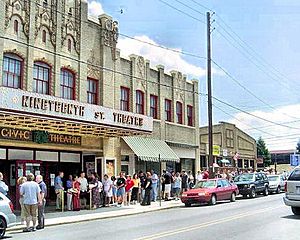
Allentown Symphony Orchestra performs at Miller Symphony Hall, located on North 6th Street in Center City. The city has a musical heritage of civilian concert bands and is home to the Allentown Band, the nation's oldest civilian concert band. Allentown houses a collection of public sculptures, including the DaVinci Horse, located on 5th Street, which is one of only three da Vinci sculptures in the world. Allentown Art Museum, located on North 5th Street in Center City, is home to a collection of over 13,000 pieces of art and an associated library. Baum School of Art at 5th and Linden streets offers credit and non-credit classes in painting, drawing, ceramics, fashion design, jewelry making, and other arts-related curriculum.
Civic Theatre of Allentown, founded in 1928, has an 90-plus year history of producing theater in the Lehigh Valley. Initially named Civic Little Theater, Civic Theatre of Allentown today has paid professional staff, a volunteer board of directors from the community, and volunteer staff. The theater operates the Lehigh Valley's only full-time cinema, showing art, independent and foreign films, and offers a theater school that has served the Valley's youth for over 50 years. The theatre is professionally directed and managed and utilizes community actors in its live theater productions.
Museums and cultural organizations
- Allentown Art Museum, art museum
- Allentown Band, nation's oldest civilian concert band
- Allentown Symphony Orchestra, symphony orchestra
- America on Wheels, automotive transportation museum
- Baum School of Art, non-profit community art school
- Civic Theatre of Allentown, historic cinema
- Da Vinci Science Center, science museum
- Lehigh County Historical Society, local historical society and museum
- Marine Band of Allentown, civilian concert band
- Municipal Band of Allentown, civilian concert band
- Museum of Indian Culture, Lenape Indian educational center
Cuisine
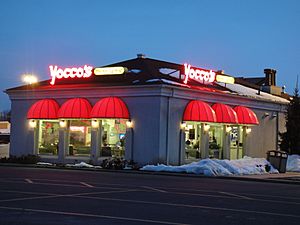
Vestiges of Allentown's Pennsylvania Dutch heritage are prominent in Pennsylvania Dutch cuisine in the city. Foodstuffs, including scrapple, chow-chow, Lebanon bologna, cole slaw, and apple butter, are often found in local diners and the Allentown Farmer's Market. Shoofly pie, birch beer, and funnel cakes are regularly available at local fairs. Several local churches make and sell fastnachts in fundraisers for Fastnacht Day, the day before Lent's commencement.
Due in part to Allentown's proximity to Philadelphia, cheesesteaks are immensely popular. Yocco's Hot Dogs, a regionally well-known hot dog and cheesesteak establishment with four area locations, two of which are in Allentown, was founded in 1922 by Theodore Iacocca, uncle of former Chrysler chairman and president Lee Iacocca. A-Treat Bottling Company, a regionally-popular soft drink beverage company, has been based in Allentown since its 1918 founding.
Landmarks and popular locations
The Soldiers and Sailors monument, which was unveiled October 19, 1899, on Allentown's Center Square at 7th and Hamilton streets, honors Union Army volunteers from Allentown and Lehigh Valley who were killed in defense of the Union during the American Civil War. The monument is topped by a statue representing the Goddess of Liberty. In 1957, the statue atop the monument was removed due to its state of disrepair and was replaced in 1964. Allentown's motto, in Latin, is Sic semper tyrannis, meaning "thus always to tyrants", suggesting that bad but justified outcomes will ultimately befall all tyrants.
Music
Allentown Band, Marine Band of Allentown, Municipal Band of Allentown, and Pioneer Band of Allentown all perform regularly at the bandshell in the city's West Park. Allentown's J. Birney Crum Stadium, the largest high school football field in the Mid-Atlantic U.S, hosts Drum Corps International's Eastern Classic, which annually brings together the world's top junior drum and bugle corps for a two-day event.
Parks
Much of Allentown's park system is a product of industrialist Harry Clay Trexler's efforts. Inspired by the City Beautiful movement in the early 20th century, Trexler helped create West Park, a 6.59-acre (26,700 m2) park in what was then a community trash pit and sandlot baseball field in an upscale area of the city. The park, which opened in 1909, features a bandshell designed by Philadelphia architect Horace Trumbauer and has long been home to the Allentown Band and other community bands. Trexler also facilitated the development of Trexler Park, Cedar Parkway, Allentown Municipal Golf Course, and Trout Nursery in Lehigh Parkway and was responsible for the development of the Trexler Trust, which provides ongoing private funding for Allentown's park system's maintenance and development.
Allentown's parks include Bicentennial Park, a 4,600 seat mini-stadium built for sporting events, the 127-acre Cedar Creek Parkway, which includes Lake Muhlenberg, Cedar Beach, and Malcolm W. Gross Memorial Rose Garden, East Side Reservoir (15 acres), Irving Street Park, Kimmets Lock Park (5 acres), Lehigh Canal Park (55 acres), Lehigh Parkway (999 acres), Old Allentown Cemetery (4 acres), Jordan Park, South Mountain Reservoir (157 acres), Trexler Park (134 acres), Trout Creek Parkway (100 acres), Joe Daddona Park (19 acres), Keck Park, Percy Ruhe Park, also known as Alton Park, and West Park (6.59 acres).
Recreation
Amusement park

Allentown is home to Dorney Park & Wildwater Kingdom, one of the nation's largest amusement and water parks. Dorney Park's Steel Force roller coaster is the eighth-longest steel rollercoaster in the world.
Festivals

The Great Allentown Fair runs annually the end of August and early September on the grounds of the Allentown Fairgrounds on North 17th Street, where it has been held continuously since 1889. The first Allentown Fair was held in 1852. Prior to moving to the Allentown Fairgrounds in 1889, it was held at the Old Allentown Fairgrounds north of Liberty Street between 5th and 6th streets.
Blues, Brews, and Barbeque, a blues festival launched in 2014, is held annually in June on Hamilton Street in Center City. Annually in May, Mayfair Festival of the Arts, a three-day arts festival, is held on Cedar Crest College campus in Allentown.
Sports
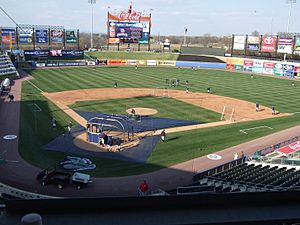
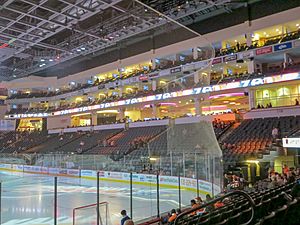
Allentown and its surrounding Lehigh Valley region are known for high quality high school-level athletics, and the region has been the starting ground for a considerable number of professional and Olympic-level athletes.
Collegiate athletics
Both Cedar Crest College and Muhlenberg College in Allentown have collegiate athletic programs in most sports. The Muhlenberg Mules play their home football games at Scotty Wood Stadium on the Muhlenberg campus in Allentown.
High school athletics
Allentown's three large high schools, Allen, Dieruff, and Central Catholic, each compete in the Eastern Pennsylvania Conference, one of the nation's premier high school athletic divisions. All three Allentown high schools play their home football games at the 15,000 capacity J. Birney Crum Stadium at 2027 Linden Street, the largest high school football stadium in the Mid-Atlantic region of the nation.
Lehigh Valley IronPigs baseball
Professional baseball has a rich history in Allentown dating back to 1884. The city is home to the Lehigh Valley IronPigs, the Triple-A Minor League affiliate of the Philadelphia Phillies who play at Coca-Cola Park, a $50.25 million, 8,200-seat stadium on Allentown's east-side.
Lehigh Valley Phantoms ice hockey
Allentown is home to the Lehigh Valley Phantoms, the primary development team of the Philadelphia Flyers, which compete in the American Hockey League and play at PPL Center, an 8,500-seat indoor arena in Center City.
Parkettes gymnastics
Allentown is home to the Parkettes National Gymnastics Training Center, which has been the training ground for several Olympians and U.S. national gymnastics champions. In 2003, the program was the subject of an immensely critical CNN documentary, Achieving the Perfect 10, which depicted it as a hugely demanding and competitive gymnastics training center.
Historical teams
Allentown hosted the Allentown Jets, a Continental Basketball Association team that played in Rockne Hall at Allentown Central Catholic High School from 1958 to 1981. The Jets were one of the most dominant franchises in the league's history, winning eight playoff championships and twelve division titles. Allentown has been home to two professional soccer teams, the Pennsylvania Stoners (2007–2009) and Northampton Laurels (2005–2008) of the now defunct Women's Premier Soccer League. The Pennsylvania ValleyDawgs of the now defunct U.S. Basketball League played their home games at William Allen High School during the league's existence from 1999 to 2006.
Education
Primary and secondary education
Allentown School District, Pennsylvania's fourth-largest school district, manages the city's public school system with the exception of a small portion of the city near Trexler Park that is in Parkland School District. Allentown has two large public high schools for ninth through 12th grades, William Allen High School, which serves students from Allentown's southern and western sections, and Louis E. Dieruff High School, which serves students from the eastern and northern parts. Each of the city's high schools competes athletically in the Eastern Pennsylvania Conference, an elite high school athletic conference, which includes the 18 largest high schools in the Lehigh Valley and Pocono Mountain regions of the state. Both schools and Allentown Central Catholic High School, the city's parochial high school, play their home football games at J. Birney Crum Stadium, the largest high school stadium in the state.
Allentown School District's four middle schools, for grades 6–8, are: Francis D. Raub Middle School, Harrison-Morton Middle School, South Mountain Middle School, and Trexler Middle School. The city is served by 16 elementary schools for kindergarten through fifth grade: Central, Cleveland, Hiram W. Dodd, Jefferson, Lehigh Parkway, Lincoln, Luis A. Ramos, McKinley, Midway Manor, Mosser, Muhlenberg, Ritter, Roosevelt, Sheridan, Union Terrace, and Washington.
Allentown also has two public charter schools: Roberto Clemente Charter School, located at 4th and Walnut streets in Allentown, is a Title I charter school that provides educational services to mainly Hispanic students in grades 6 through 12, and Lincoln Leadership Academy Charter School, located at 1414 E. Cedar Street, is open to K to 12 students.
Other Allentown-based parochial schools serving K to 8 include Saint John Vianney Regional School, Holy Spirit School, Lehigh Christian Academy, Mercy Special Learning Center, Our Lady Help of Christians School, Sacred Heart School, and Saint Thomas More School. Roman Catholic-affiliated parochial schools in Allentown are operated by the Roman Catholic Diocese of Allentown. Grace Montessori School is a pre-school and early elementary Montessori school run as an outreach of Grace Episcopal Church. Allentown has one private Jewish school, Jewish Day School, and two independent day schools, CAI Learning Academy, an independent day school, and The Swain School, which is associated with Moravian Academy. Newcomer Academy at Midway Manor or the Allentown School District Virtual Academy for eighth through 12th grades.
Colleges and universities
Two four-year colleges, Cedar Crest College and Muhlenberg College, are based in Allentown. The city is also home to a satellite campus of Lehigh Carbon Community College (LCCC), a comprehensive community college that offers two-year and four-year degree programs, continuing education, and industry training whose main campus is in Schnecksville.
Media
Television
Allentown is part of the Philadelphia media market, the fourth-largest television market in the nation. Major Philadelphia-based network stations serving Allentown include KYW-TV Channel 3 (CBS), WCAU Channel 10 (NBC), WPVI Channel 6 (ABC), and WTXF Channel 29 (Fox). Two television stations are located in Allentown: WFMZ-TV Channel 69, based in Allentown with studios and a transmitting site atop South Mountain, is an independent station, and WLVT-TV Channel 39, the regional PBS affiliate, is licensed to Allentown with studios in neighboring Bethlehem.
Radio
Nielsen Audio ranks Allentown the nation's 74th-largest radio market as of 2022. Stations licensed to Allentown include WAEB-AM (talk, news, and sports), WAEB-FM (contemporary hits), WDIY (NPR public radio), WHOL (rhythmic contemporary), WLEV (adult contemporary), WMUH (Muhlenberg College freeform campus radio), WSAN (oldies and Philadelphia Phillies broadcasts), WZZO (classic rock), and others. In addition, many stations from New York City, the nation's largest radio market, and Philadelphia, the nation's fourth-largest radio market, are received in Allentown.
Newspapers and magazines
Allentown has two daily newspapers, The Morning Call and The Express-Times. The Times News, based in Lehighton, also covers the city. Several weekly and monthly print publications are based in Allentown or cover the city's news and people.
Transportation
Airports
The city's primary commercial airport, Lehigh Valley International Airport, is located 3 miles (4.8 km) northeast of Allentown in Hanover Township and is operated by Lehigh–Northampton Airport Authority. The airport has direct flights to Atlanta, Charlotte, Chicago–O'Hare, Detroit, Philadelphia, and several cities in Florida. The region is also served by Allentown Queen City Municipal Airport, a two-runway facility located on Lehigh Street in South Allentown used predominantly by private aircraft.
Roads
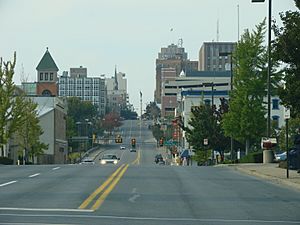
There are 314.10 miles (505.49 km) of public roads in Allentown, 26.16 miles (42.10 km) of which are maintained by the Pennsylvania Department of Transportation (PennDOT) and 287.94 miles (463.39 km) that are maintained by the city as of 2022.
The most prominent highway passing through Allentown is Interstate 78, which runs concurrently with Pennsylvania Route 309 along an east–west alignment across the southern portion of the city. I-78 runs from Lebanon County in the west to the Holland Tunnel and Lower Manhattan in the east, while PA 309 runs from Philadelphia in the south to the Wyoming Valley in the north. U.S. Route 22 briefly passes through the northwestern corner of the city as it follows the Lehigh Valley Thruway along an east–west alignment; it runs from Cincinnati, Ohio in the west to Newark, New Jersey in the east.
There are nine major inbound roads to Center City: Airport Road, Cedar Crest Boulevard, Fullerton Avenue, Hamilton Boulevard, Lehigh Street, Mauch Chunk Road, MacArthur Road, Tilghman Street, and Union Boulevard. Interstate 476, the Northeast Extension of the Pennsylvania Turnpike, passes to the west of the Allentown city limits. It runs from Plymouth Meeting outside Philadelphia in the south to Interstate 81 at Clarks Summit in the north.
Private and public bus services
Public buses in Allentown are provided by LANta, a bus system serving Lehigh and Northampton counties. Allentown Transportation Center, located on North 7th Street, serves as a major hub for LANTA buses.
Multiple private bus lines serve Allentown at the intercity terminal at 325 Hamilton Street, including Trans-Bridge Lines and Greyhound Lines, offering direct bus service throughout the day to Port Authority Bus Terminal in Manhattan and intermediate points, and Fullington Trailways, which offers direct service to Williamsport, Hazleton, Philadelphia, and intermediate points. Martz Trailways stops in Allentown as part of its route between Scranton/Wilkes-Barre and Philadelphia and its commuter routes to New York City, which are part of the Amtrak Thruway that connects Amtrak trains at 30th Street Station in Philadelphia with the Lehigh Valley and Northeastern Pennsylvania. Public parking in the city is managed by the Allentown Parking Authority.
Rail
Allentown is a regional center for freight transport. Norfolk Southern Railway's primary Northeast hump classification yards are located in Allentown, and the city is served by R.J. Corman Railroad Group, a commercial railroad company. Major commercial rail traffic in the city includes the Norfolk Southern Lehigh Line, which runs east through the city across the Delaware River, and Norfolk Southern's Reading Line, which runs west through Allentown to Reading.
The last passenger rail service in the city, which was provided by SEPTA, ceased operating in 1979, though one of SEPTA's two main Allentown train stations remains standing. In September 2020, Amtrak, as part of its expansion plan, proposed restoring rail service between Allentown and New York City by 2035. This largely single-track Amtrak route has been opposed by Norfolk Southern Railway, which acquired the Lehigh Line as part of its purchase of federally-founded Conrail in 1999. In November 2008, the Lehigh Valley Economic Development Corporation (LVEDC) and both Lehigh and Northampton counties commissioned a study, exploring restoration of the Black Diamond service, which ran until 1961, which would entail extending New Jersey Transit's Raritan Valley Line to Allentown.
Allentown was once a passenger rail hub served by the Central Railroad of New Jersey, using the Lehigh and Susquehanna Railroad, Lehigh and New England Railroad, Lehigh Valley Railroad, Reading Railroad, Lehigh Valley Transit Company, and Conrail. Routes served Wilkes-Barre and Scranton to the north, Buffalo and Williamsport to the northwest, Reading and Harrisburg to the west, Jersey City and New York City to the east, and Philadelphia to the south.
Utilities
Electricity in Allentown is provided by PPL Corporation, which is headquartered in Allentown. UGI Corporation, headquartered in King of Prussia, supplies natural gas. Two cable companies, RCN Corporation, based in Princeton, New Jersey, and Service Electric, based in Bethlehem, have provided cable service to Allentown since the 1960s. The area's only landfill, Waste Connections of Canada, is locally headquartered in Bethlehem. Water and sewage, prior to 2013, were controlled by the city and are now managed by Lehigh County, following the end of a 50-year lease agreement. Waste, recycling, and yard waste are each administered by the city.
Fire department
The Allentown Fire Department, established in 1870, operates six fire stations in the city.
Notable people
Since its 1762 founding, Allentown has been the birthplace or home to several notable Americans, including:
- Saquon Barkley, professional football player, Philadelphia Eagles, and 2018 NFL Offensive Rookie of the Year
- Stephen Barrett, former psychiatrist and co-founder, Quackwatch
- Clair Blank, former author, Beverly Gray mystery series
- Chakaia Booker, sculptor
- Lillian Briggs, former rock music singer
- Thom Browne, fashion designer
- Frank Buchman, founder, Oxford Group and Moral Re-Armament religious movements
- Howard J. Buss, composer and music publisher
- Leon Carr, former Broadway composer and television advertising songwriter
- Alexis Cohen, former American Idol contestant
- Michaela Conlin, film and television actress, Fox's Bones
- Dane DeHaan, film and television actor, In Treatment and Chronicle
- Stanley Dziedzic, freestyle wrestling Olympic bronze medalist, 1976 Summer Olympics, and 1977 World Wrestling Championships champion
- Gloria Ehret, former professional golfer and 1966 LPGA Championship winner
- Oakes Fegley, actor
- Winslow Fegley, actor
- Victoria Fuller, sculptor
- James Knoll Gardner, former U.S. federal judge
- Billy Kidman, former professional wrestler
- Scott Haltzman, psychiatrist, relationship counselor, and author
- Tim Heidecker, film and television actor, Tim and Eric Awesome Show, Great Job!
- Lee Iacocca, former chairman, Chrysler
- Sam Iorio, professional basketball player, Hapoel Be'er Sheva B.C. in the Israeli Basketball Premier League
- Keith Jarrett, jazz musician
- Michael Johns, healthcare executive and former White House presidential speechwriter
- Sarah Knauss, supercentenarian, longest-lived American ever, third oldest person verified to have ever lived
- Brian Knobbs, former professional wrestler
- Sally Kohn, political commentator
- Carson Kressley, television personality and designer
- Varvara Lepchenko, professional tennis player
- William Marchant, former playwright and screenwriter
- Tyrese Martin, professional basketball player, Brooklyn Nets
- Ed McCaffrey, former professional football player, Denver Broncos, New York Giants, and San Francisco 49ers
- Lara Jill Miller, actress and voice actress
- Hans Moller, former painter
- Aimee Mullins, Paralympian, model, actress
- Lawrence Nuesslein, former five-time Olympic shooting medal winner, 1920 Summer Olympics
- Lil Peep, former emo rapper, singer, songwriter, and model
- Marty Ravellette, armless rehabilitation patient who saved an elderly woman from a burning car
- Anthony Recker, former professional baseball player, Atlanta Braves, Chicago Cubs, New York Mets, and Oakland Athletics
- Andre Reed, former professional football player, Buffalo Bills and Washington Redskins, and Pro Football Hall of Fame inductee
- Ian Riccaboni, professional wrestling sportscaster, Ring of Honor professional wrestling
- Matt Riddle, professional wrestler, Major League Wrestling
- Jerry Sags, professional wrestler
- Larry Seiple, former professional football player, Miami Dolphins, two-time Super Bowl champion
- Amanda Seyfried, actress, Veronica Mars, Big Love, Mamma Mia!, and Les Misérables
- Dana Snyder, voice actor, Adult Swim
- Andrea Tantaros, former political analyst and commentator
- Christine Taylor, actress and wife of actor Ben Stiller
- Mildred Ladner Thompson, former Wall Street Journal reporter
- DeNorval Unthank, former physician and civil rights activist
- Donald Voorhees, former Emmy-nominated orchestral conductor
- Jamie Weinstein, political journalist and commentator
- Lauren Weisberger, author, The Devil Wears Prada
- Hana Wirth-Nesher, literary scholar and university professor, Tel Aviv University
- Chris Wyles, former professional rugby union player, Saracens F.C., and U.S. national rugby team player
See also
 In Spanish: Allentown (Pensilvania) para niños
In Spanish: Allentown (Pensilvania) para niños




